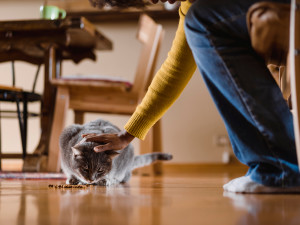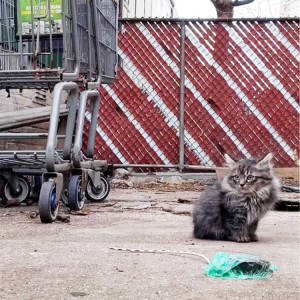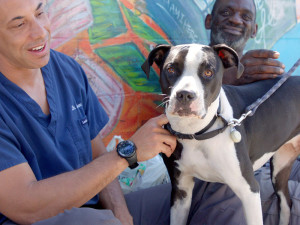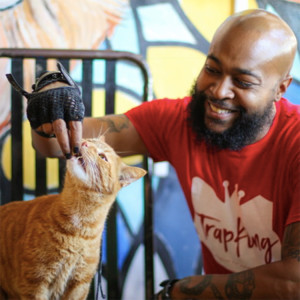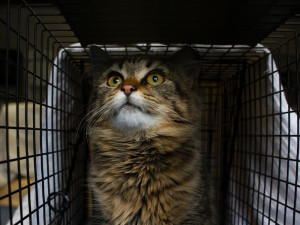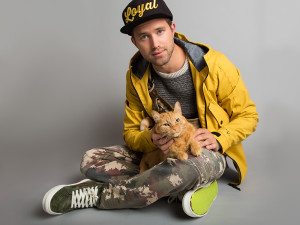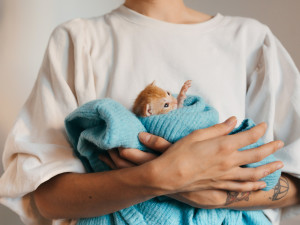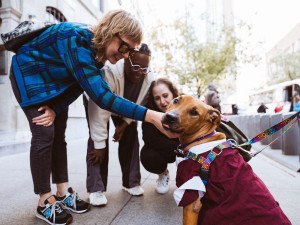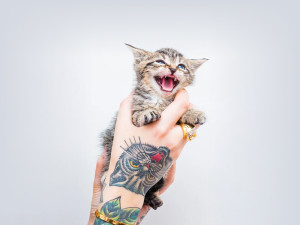How One New York City Domestic Violence Shelter Aims to Expand Care to Survivors’ Pets
The New York-based organization wants domestic violence shelters across the country to house and provide for pets, too.
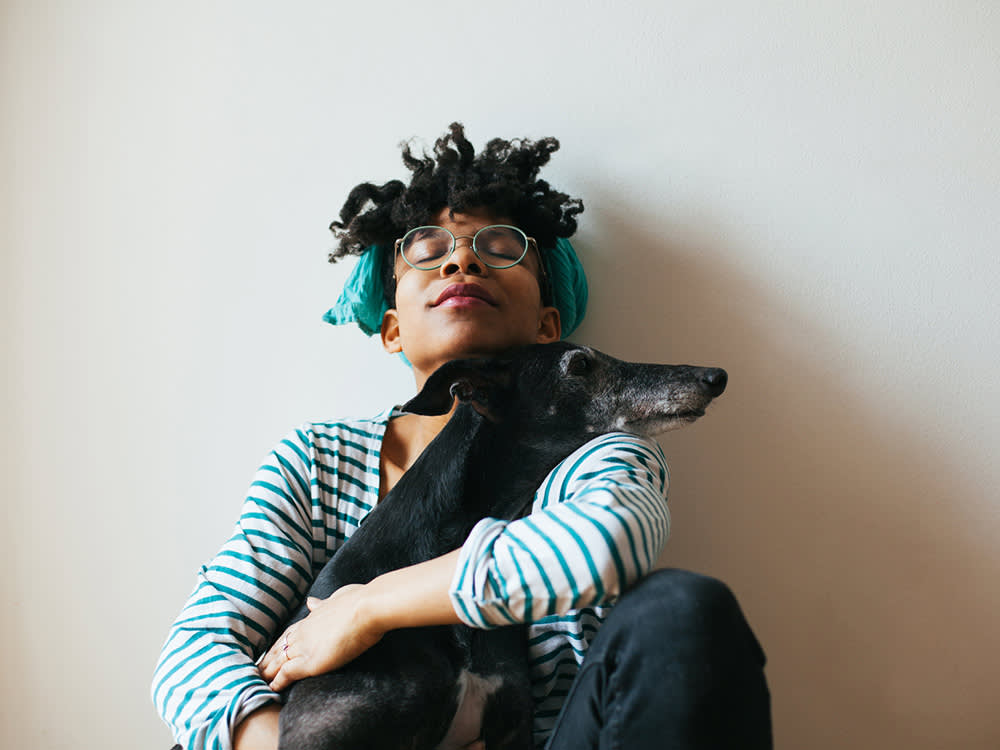
share article
Any pet parent knows how much we receive from our pets: love, companionship, joy, someone to talk to in a ridiculously cutesy voice — the list is never-ending. In return, we try to offer our pets the same, as well as the basics, like food, shelter, and safety. So, it’s understandable why he overwhelming majority of pet parents who find themselves in situations of violence or trauma wouldn’t dream of leaving their pets behind in seeking shelter and safety. In fact, according to a joint report opens in a new tabbetween the National Domestic Violence Hotline and the Urban Resource Institute, 97 percent of respondents to a survey of 2,500 domestic violence survivors said that keeping their pets with them was an important factor in deciding whether or not to seek shelter.
Unfortunately, the systems in place to help humans escape abuse, trauma, or homelessness are overwhelmingly not welcoming to their pets; only 12 percent of domestic violence programsopens in a new tab can provide shelter for pets.
The Urban Resource Institute (URI) — an organization that aimsopens in a new tab to “empower individuals, families, and communities, particularly communities of color and other disenfranchised populations, to end cycles of violence, homelessness, poverty, and trauma by increasing safety and resiliency” — wants to change that. The New York City-based organization is currently the only one in the entire city that offers shelter facilities that not only welcome pets but specifically provide support for them, including food, vet care, and designated outdoor areas for exercise, through their People and Animal Living Safely (PALS)opens in a new tab program.
In May, URI took a big step toward helping make others shelter welcoming to pets by publishing the Pawprintopens in a new tab, a policy document that serves as a roadmap for lawmakers on the city, state, and federal levels to do just that.
Lauren Schuster, the Vice President of Government Affairs at URI, spoke to The Wildest about how URI’s PALS program has already affected survivors and their pets and how the Pawprint aims to spread that impact across the city, state, and country.
What do you do at the Urban Resource Institute (URI)opens in a new tab?
I’m the Vice President of Government Affairs at URI. Before I started, URI did not have a government affairs department. I think a variety of different individuals within the organization handled relationship-building with elected officials and government agencies. As URI has grown over the years, and we have experienced some really tremendous and dynamic growth — I think they recognized the need to have a department dedicated specifically to policy change and building relationships with elected officials, so that we have the resources to do the work that we’re doing. And so, I’ve spent this last year (I just celebrated my one-year anniversary) building out our department and trying to create avenues for advocacy and policy reform.
At The Wildest, we’re fans of the work the URI has done to help domestic violence survivors and their pets through the People and Animal Living Safely (PALS) program. Can you tell us a little more about it?
The PALS program copens in a new tab reates an opportunity for people and their pets to co-live in our shelters. When somebody comes to us with a pet, we’ll provide that individual or family and their pet with all the things that they need to rebuild their lives in our temporary shelter. We provide anything from all of the things you need to fill a kitchen and a bathroom to species-specific supplies — whether that’s a crateopens in a new tab or leash opens in a new tabfor a dog or litter boxes opens in a new taband litter for cats. Through a partnership with the ASPCA, we’re able to provide free veterinary care and behavioral support to the animals in our shelters.
Some of our sites have pet parks or pet havens: outdoor areas that are private and separated from the public, where our survivors can bring their pets to walk them to get them exercised outside, but not have to expose them to anything public if they don’t feel safe to do so. We also have grooming stations in some of our sites, and sometimes we even have groomers come in and do that work. We’re really not just supporting the people through our PALS program — we’re also supporting their pets.
It seems so crucial that people can take their pets with them when they have to leave an unsafe environment.
I think it’s really important to note that we did a study at the midpoint of the PALS program, and we learned that 50 percent of survivors said they would not have left an abusive situation if they couldn’t take their pets with them. For a lot of people who have experienced the trauma of domestic violence or homelessness and poverty, oftentimes, their pets are their sole source of support. And so maintaining that relationship is important not just to help them leave a dangerous situation or get off the streets and into housing but also in their healing process.
When we piloted PALS in 2013, we were the first organization to do so in New York City, and in those 10 years, we have grown to have PALS capabilities in nine of our sites, and we’ve served just under 700 animals in that time. We still remain the only organization to allow co-living with pets.
Why do you think other organizations haven’t established co-living with pets in their shelters? What roadblocks have they faced in doing that?
I think it’s funding. Over the years, funding for homelessness prevention and domestic violence services has lagged far behind the scope and scale of the problem. When you’re in an environment where the problem so significantly eclipses the amount of funding you have, it’s hard to find dollars to accommodate pets as well.
I think there is a real education gap among policymakers, too. We’re trying to educate them about how allowing co-living with pets will help ensure that people get out of dangerous situations and find safe, stable temporary housing so that we can ultimately get them into permanent housing. That’s everybody’s goal, but people aren’t necessarily clear on how to do that — and allowing co-living is one way to do that. We are really committed in the next five to 10 years to expanding PALS beyond our nine shelters and the URI. The goal is for other organizations to adopt PALS.
Why is expanding PALS important? Can you tell us about the impact the program has had in New York City?
We had an elected official’s office call us a few months ago — this elected official had a constituent who was forced to leave an abusive situation and had a dog with her. She could not find any shelter in the city that would allow her and her dog to enter. And so she went to PATHopens in a new tab, where you enter the city’s homeless system — they guide you to where there’s capacity. And they said no dogs [were allowed] unless [they were] a service or emotional support animal. This constituent was riding the subway, sleeping on the subway with her dog for days and days and days.
That’s horrible. How did she get connected to PALS?
Finally, out of desperation, she went to her elected official’s office, who luckily knew about us. They reached out, and we were able to get her and her dog into shelter. This constituent called her elected official crying. She was like, “It’s not just a shelter; they gave me dog food, they gave me a leash, there’s a backyard for my dog to run in.”
Imagine leaving your home with a backpack and a dog, having no idea where you’re going to go, and then going everywhere, knocking on 100 doors, and being turned away. I can’t even conceive of how scary that must have been. And now you multiply that times as many people who have experienced domestic violence and also have dogs or cats or lizards — whatever pet it is. This program is for every person who loves their animal and would never leave their animal behind. I never would.
The Pawprint, a policy document the URI released in May, aims to make PALS more accessible to more communities. Can you tell us about how it came to be?
The Pawprint came out of conversations with our PALS team — with our leadership and with our clients — to understand what they need and what they identify as obstacles. We also talked to other agencies who aren’t implementing programs like PALS and asked what they need. And so, all of the policies the Pawprint poses aim to plug holes, solve existing problems, and remove obstacles for providers so that they can remove those obstacles for their clients. We spent a lot of time just listening, learning, and understanding.
The Pawprint suggests federal, state, and city legislation to help support people in need of shelter and their pets. Let’s start on the federal level — what federal legislation does this document propose?
The federal legislation we suggest is designed to help finance PALS programming because many organizations don’t have the relationships we’ve built over the years to help us finance this project.
For example, the URI has received funding from the PAWS Actopens in a new tab, which provided $3 million in grant funding to agencies allowing domestic violence survivors to co-live with their pets. There were far more organizations that tried to secure funding through the PAWS Act than received it — I think more than double the amount that actually received it applied — so there is a significant desire among providers to be able to do this for survivors of domestic violence. We’re trying to create the resources to allow them to do that.
How did the PAWS Act come about?
The PAWS Act was initially authorized through the 2018 Farm Bill. We are now working with a coalition of organizations across the country to ensure that the PAWS Act is included in the Farm Bill reauthorizationopens in a new tab, which is currently being negotiated. We’re trying to increase the funding to $5 million.
The PUPP Actopens in a new tab, another federal bill that was recently introduced, would authorize the USDA and HUD to create a $3 million grant program for agencies that allow co-living for people experiencing homelessness and their pets. This is hugely important because we know that so many of our survivors end up in homeless shelters either because they time out of our domestic violence shelter system as a matter of regulation or because there aren’t enough beds in that system, and so they are forced into the homeless system. Also, homelessness in and of itself is a trauma; poverty is a trauma. Being able to keep your animals with you hopefully helps get you off the street and into shelter and helps you heal and get into permanent housing.
What does the Pawprint propose on the state level?
The number of people experiencing homelessness is increasing — the crisis is worse than it’s ever been before; [around] 29,000 childrenopens in a new tab sleep on the streets each night in New York. And the resources are scarce for this work, and it’s an expensive endeavor. So I think a lot of providers struggle with, “How do we pay for this?”
So, one state-level bill would create a capital and operational fund to help finance any structural changes that are needed at shelter sites that already exist, as well as veterinary care, food, sanitation, etc.
The other state-level bill would allow veterinarians to satisfy a portion of their continuing education requirements by providing free veterinary care to animals who are in shelter with their people. We think this is a really smart way to get veterinarians involved in the problem. So many of them want to help and don’t know how, and so this way, they’ll satisfy their credits and help organizations and agencies afford this care.
And what about the city level?
We’re working on legislation that would help ensure that co-living is permissible in every single shelter city-wide. URI is interested in expanding our PALS program to all our sites; we think co-living should be available everywhere, and we want to ensure that people experiencing homelessness also have the opportunity for co-living.
We’re also working on a training and technical assistance bill. One of the obstacles for other shelter providers is that they don’t know where to start — it feels like a daunting process [to implement co-living]. Over the years, URI has had these questions, and we’ve answered them, so we think that standardizing a training and technical assistance program for the city will make it much easier for other organizations to take up the PALS program. It’ll also ensure quality and minimum standards at those programs because we want to make sure that everybody is getting the same level of care.
Can you walk us through how you plan to take the Pawprint from a document to policies that are put into action?
So, it’s different on the city, state, and federal level, but I’ll give you a general sort of guideline as to how we do this.
On the federal level, the PAWS Act and the PUPP Act exist already, so we are calling [on] all of our New York State members of Congress and Senate to ensure that they support this legislation being included in the Farm Bill. We’re working with a broad coalition of groups from across the country — other organizations in the United States allow co-living, even in New York State (just not New York City) — to build capacity.
On the city and state levels, we identify politicians and legislators who we think are interested in and care about our work, whether that is homelessness and housing, domestic violence and violence prevention, or animal welfare — ideally, it’s all three. Then we reach out and ask them if they want to champion these issues and provide them with the tools they need to advocate for the issue with their colleagues and get a critical mass of support. And then, hopefully, we get these bills passed.
What’s the timeline for implementing the legislation proposed in the Pawprint?
Only one of the state bills is close to being introduced so far — that’s the veterinarian continuing education bill. But we’ve identified sponsors for that piece of legislation and are working with them all now.
In terms of the federal legislation, it seems like the timeline is up in the air as a result of some of the ongoing craziness in Congress. There’s talk that the Farm Bill will be delayed substantially and that they’ll just pass an extender, but we’re never going to rest on our laurels as a coalition, so we are working to build capacity and pressure and advocacy now. So, it’s a slog, but this is great, important, meaningful work that will make a real impact in people’s lives. So, it’s exciting to be embarking on this journey.
What can people do to support the Pawprint and advocate for its policies to be enacted?
Call your member of Congress and ask them to ensure that the PAWS Act is included in the Farm Bill and to co-sponsor the PUPP Act. Without a doubt, that should be happening now. We think the state has a moral obligation to do this because our goal is to end homelessness and domestic violence, and we’ve identified this is a major barrier to doing that.
This is the beginning. And it’s a lot. This is hardly a one-year platform. But we think there are a lot of opportunities to expand and we're really excited about the next 10 years of PALS.

Julie Zeilinger
Julie Zeilinger is a NYC-based writer and editor whose writing has been published in Marie Claire, Vox, HuffPost, Forbes, and other publications. She is also the author of two books: College 101: A Girl’s Guide to Freshman Yearopens in a new tab (2014) and A Little F’d Up: Why Feminism Is Not a Dirty Wordopens in a new tab (2012). She is the mom to Baloo, a two-year-old Bichpoo and foster mom to dogs via Badass Animal Rescueopens in a new tab.
Related articles
![A fluffy red-brown cat in a crate]() opens in a new tab
opens in a new tabHow Flatbush Cats Is Saving Brooklyn’s Strays
Ad agency strategist Will Zweigart founded a nonprofit to tackle the neighborhood’s street cat epidemic.
![Nathan sitting on the floor with a cat in front of a gray background]() opens in a new tab
opens in a new tabMeet “Nathan the Cat Lady” — Model, Actor, Cat Dad Extraordinaire
For Nathan Kehn, building cat forts, scooping litter boxes, and traveling the country to rescue stray kitties is all in a day’s work.
![anonymous woman pampering and taking care about a small ginger kitten]() opens in a new tab
opens in a new tab6 Ways to Help Local Shelters Without Committing to Full-Time Pet Parenthood
Adoption isn’t for everyone—here are other ways you can be there for animals in need.
![Group of young people pet a brown dog with a jacket on outside.]() opens in a new tab
opens in a new tabHow DIY Animal Rescuers Tell The Exhausting, Rewarding Stories of Their Work
In volunteers’ Instagram videos, you’ll see both the joy and the fatigue behind finding these deserving pets homes.
![A hand holding a kitten with a cat tattooed at the hand.]() opens in a new tab
opens in a new tabHeads Up: It’s Officially “Kitten Season”
Hannah Shaw, aka Kitten Lady, on how you can care for orphaned kittens this spring.


